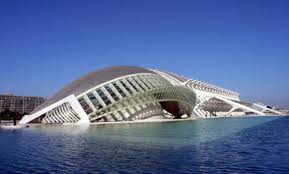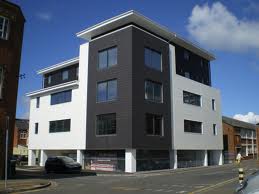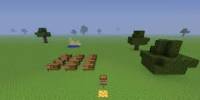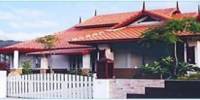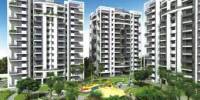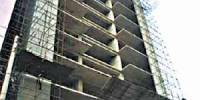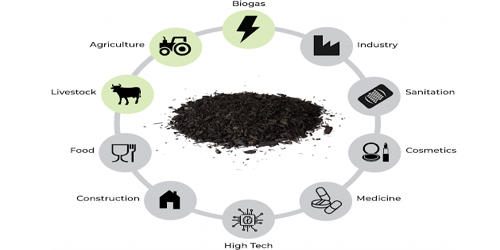INTRODUCTION:
General:
Bangladesh is one of the most density populated countries of the world. The population of Dhaka city is much higher than its capacity. The pressure on the land is tremendous, land value is already very high and continuously increasing. People who cannot have a piece of land can have a flat or apartment and it is also likely that he will have a car. Due to higher land value or due to lack of sufficient land, people do not get large space. So the building should not have sufficient space for parking. Again parking maneuver is very difficult is closely spaced column areas. It may not be feasible to have separate land for parking due to lack and highly priced land adjacent to the building. The most feasible option would have been the parking facilities within the building in the ground floor.
The building having more columns in the ground floor reduces the open space in the ground or parking floor. The parking area can be significantly increased if the building can be built with less number of columns in the ground floor. This thesis focuses in the analytical study supported by design of a four storied building built over 2 kathas (1440 sft ) of land for two alternatives, one having 11 columns at ground floor and 16 columns on all over floors, others having 16 columns on all the floors.
This will give a comparative picture about the advantages and disadvantages, suitability and feasibility, particularly in terms of economy so as to enable someone to choose the suitable option.
Objective of the Study:
The objectives of the study were:
- To explore the possibility of obtaining an uninterrupted column free space for a relatively small piece of land by eliminating interior columns at ground floor.
- To analyze of a four storied building built over 2 kathas (1440 sft ) of land for two different framing systems, one with 16 columns for all floors and the others having 11 columns at the periphery and bracing system at the ground floor, the remaining floors will have 16 columns.
- To identify the proper location of bracing at ground floor in order to reduce the stress results in the structural members.
- To compare the above two alternatives particularly in terms of economy.
Scope of the study:
The scope of the study is as follows:
i. Analysis Phase
- Structural analysis by using ETABS Analysis.
ii. Design & Estimation Phase
- Beam & Column Design & Estimation through manual calculation.
Organization of the Thesis Works:
The thesis has been arranged in the following order also including as well as appendices used for the study-
Chapter- 1: Includes a brief introduction, objectives of the study and organizations of the
thesis paper.
Chapter- 2: Includes compilation of the relevant literature that has been reviewed for the
study.
Chapter- 3: Includes a detailed description of the analysis.
Chapter- 4: Includes the comparison of the results of analysis.
Chapter- 5: Includes conclusions and recommendations for further study.
LITERATURE REVIEW
General :
Now a days the parking problem in residential buildings has become a great problem because many of the buildings are build over a small piece of land which are four, five or six storied. Many of the residents have their own car and every one need a sufficient parking space and easy parking maneuver. But the column spacing in fact omitting the interior columns then the parking provision will be improved. But it will have to remember in mind that economy is an important factor in this matter. This is a recent problem in our country. So many researches have not been produced regardless of this matter and in the developed country people do not face such kind of problem due to the small piece of land because their population growth is not as high as ours and their every city is sufficiently planned.
This thesis is a comparative study on the performance of two four storied buildings built over 2 katha (1440 sft) of land is made. The buildings considered are a similar type, only greater floor area is taken but one with 16 columns and other with 11 columns at the ground floor. The rest of the floors of each building have 16 columns. This study has been made mainly to explore the possibility of obtaining an uninterrupted column free space for such a small piece of land. The linear elastic analysis was made using ANSYS finite element package. Both 2D and 3D analysis were performed to obtain the stress resultants for different structural elements of the buildings. Different load combinations were considered in the analysis. The second conditioned building bracing system will be provided at the ground floor. The proper position of the bracing will have to be located and be made the proper design of the bracing.
Now the main focus is to make the building economical with sufficient parking space and increase lateral stability.
Concrete structures: design components & types
Generally, a concrete structure is made of a set of frames consisting of several vertical and horizontal members. That is why , it is known as “ frame structure”. There are two types of frame structures:
- Low Rise Structures: Total height is 40~60 ft above the ground level. Earthquake and wind lodes are not considered during design of such Structures.
- High Rise Structure : Total height is more than 60 ft above the ground level . Earthquake and wind loads are considered during design of such structures.
The whole frame structure is divided into three parts, They are-
a) Superstructure : This is the portion which is above the ground level and consisted of the following design components:
i. Beams – All horizontal reinforced concrete member.
ii. Slabs – Plain and flat reinforced concrete surface , which rest on beams.
Two types: 1. Roof –Top slabs
2.Floors – all slabs except the top one.
iii. Columns – all vertical reinforced concrete member on which beam rest.
b) Substructure: Portion of the structure , which is below the ground level. Basement floor , car parking etc. are constructed under the ground. Substructure also consists of beams, slabs and columns.
c) Foundation: This is the portion on which the total structure rest. Foundation of a structure may be footing or piling type
Review of the structural elements of a building
Slab:
The slab provides a horizontal surface and is usually supported by column, beams or walls. Slabs can be categorized into two main type : one –way slabs and two – way slabs. One – way slabs is the most basic and common type of slab. One – way slabs are supported by two opposite sides and bending occurs in one direction only. Tow – way slabs are supported on four
Sides and bending occurs in two directions. However, slabs supported by four sides may be assumed as one- way slab when the ratio of length to width of two perpendicular sides exceeds 2. Although while such slabs transfer their loading in four directions, nearly all load is transferred in the short direction.
Two- way slabs carry the load to two directions, and the bending moment in each direction is less than the bending moment of one – way slabs. Also two – way slabs have less deflection than one – way slabs . Compared to one – way slabs, Calculation of two – way slabs is more complex.
Types of slab:
Mainly two types of slab, they are-
1) One way slab and
2) Two way slab
Different types of one way slab-
a) One way beam slab
b) One way flat slab
c) One way joist floor system
Different types of two way slab-
a) Two way Beam slab
b) Two way flat slab
c) Two way waffle slab
Beam slab is supported by beams, for this reason the loads are transferred to all floor beams. A flat slab usually does not have beams or girders but is supported by drop panels or column capitals directly. All loads are transferred to the supporting column, with punching shear resisted by drop panels. Waffle slab consists of a floor slab with large-to-width ratio less than 2, supported by waffles.
Beam:
Beam can be described as member that are mainly subjected to flexure and it is essential to focus on the analysis of bending moment, shear, and deflection. When the bending moment acts on the beam, bending strain is produced. The resisting moment is developed by internal stresses. Under positive moment, compressive strains are produced in the top of beam and tensile strains in the bottom. Concrete is a poor material for tensile strength and it is not suitable for flexure member by itself. The tension side of the beam would fail before compression side failure when beam is subjected a bending moment without the reinforcement. For this reason, steel reinforcement is placed on the tension side. The steel reinforcement resists all tensile bending stress because tensile strength of concrete is zero when cracks develop. In the Ultimate strength design (USD), a rectangular stress block is assumed. The design of beam is initiated by the calculation of moment strength controlled by concrete and steel.
Types of beam:
Most common shapes of concrete beams:
a) Single reinforced rectangular beams,
b) Doubly reinforced rectangular beams,
c) T – shape beams;
d) spandrel.
In cast – in- place construction, the single reinforced rectangular beam is uncommon. The T-shape and L-shape beams are typical types of beam because the beams are built monolithically with the slab. When slab and beams are poured together, the slab on the beam serves as the flange of a T-beam and the supporting beam below slab is the stem or web. For positive applied bending moment, the bottom of section produces the tension and the slab acts as compression flange. But negative bending on a rectangular beam puts the stem in compression and the flange is ineffective in tension. Joists consist of spaced ribs and a top flange.
Column:
Columns support primarily axial load but usually also some bending moments. The combination of axial load and bending moment defines the characteristic of column and calculation method. A column subjected to large axial force and minor moment is design mainly for axial load and the moment has little effect. A column subjected to significant bending moment is designed for the combined effect. The ACI Code assumes a minimal bending moment in its design procedure, although the column is subjected to compression force only. Compression force may cause lateral bursting because of the low- tension stress resistance. To resist shear, ties or spirals are used as column reinforcement to confine vertical bars. The complexity and many variables make hand calculations tedious which makes the computer – aided design very useful.
Types of column
Reinforced concrete column are categorized into five main types-
a) Rectangular tied column,
b) Rectangular spiral column,
c) Round column,
d) Spiral column, and
e) Columns of others geometry ( Hexagonal, L-shaped, T- Shaped, etc ).
Tied columns have horizontal ties to enclose and hold in place longitudinal bars. Ties are commonly No. 3 or No. 4 steel bars. Tie spacing should be calculated with ACI Code. Spiral columns have reinforced longitudinal bars that are enclosed by continuous steel spiral. The spiral is made up of either large diameter steel wire or steel rod and formed in the shape of helix. The spiral columns are stronger than tied columns.
Footing
The foundation of a building is the part of the structure that transmits the load to ground to support the superstructure and usually the last element of a building to pass the load into soil, rock or piles. The primary purpose of the footing is spread the loads into supporting materials so the footing has to be designed not to be exceeded the load capacity of the soil or foundation bed. The footing compresses the soil and causes settlement.
Types of Footing
The most common types of footing are strip footings under walls and single footings under columns.
Common footing can be categorized as follow-
a) Individual column footing
b) Wall footing
c)Combined footig
d) Mat foundation
METHODOLOGY OF THE STUDY
General :
This chapter gives the outlines of the procedures that were that followed to complete this study. Few steps were considered, many references were gone through and ACI /BNBC Building Design Codes/Specifications were followed to get perfect result so that the objectives of this study can be fulfilled.
Design data and specifications considered in this study
The whole study was carried out based on few considerations and specifications which are summarized in Table 3.1 below.
Table 3.1 Summary of the design considerations and specification of the study
| Items | Description |
| Design method | Ultimate Strength Design ( USD ) |
| Design Code | For design purposes: |
- American Concrete Institute ( ACI ) Building design code, 2005
- Bangladesh National Building code ( BNBC ), 1993
For estimation and costing:
- Schedule of rate for Civil Works, 12 edition, Public Works Department (PWD), 2008.
Type of structures
- Beam Supported slab system
Building system
- Frame structure
- Low rise
- Residential ( 4 storied single unit building)
| Items | Description |
| Material properties |
|
| Loading |
|
| Members Sectional properties |
|
ANALYTICAL STUDY
General:
The analysis is made by using ETABS finite element package. Here different conditioned building will be analyzed and from these results, will be considered that condition which will satisfy the requirements. For this purpose different terms and condition will be used. Finally the governing condition will be used. The whole analysis will be done based on ACI and BNBC code.
The Building Geometry:
The building geometry is as follows:
Option I Building: All the floors have 16 columns and all story height is 10 ft. Typical column size is 10″ x 15″ and typical beam size is 10″ x 12″. The layout is shown in the figure- 4.1
Option II Building: Bottom story have 11 columns but other story have 16 columns. All story height 10 ft. Column and Beam size will be selected in accordance with analysis. A special in the figure- 4.4
The loads considered:
Dead loads, D. L. = 40 psf
Floor finish, F.F = 30 psf
Live load, L.L. = 40 psf
Load combination:
DCON 1 = 1.4 D.L.
DCON 2 =1.4 D.L. + 1.7 L. L.
Legends:
D.L. = Dead load
L.L. = Live load
Beam and Column layout of option I and option II building
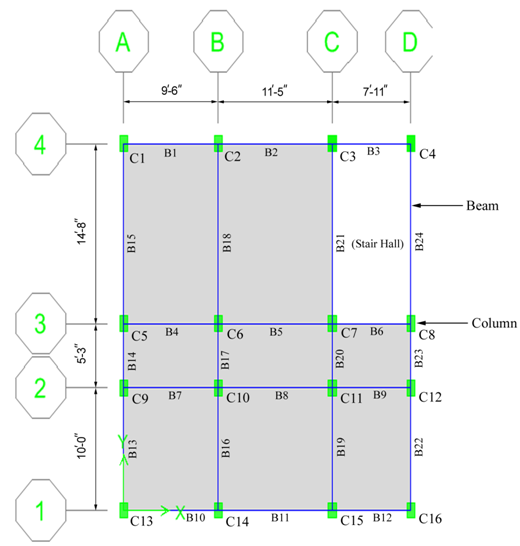
Figure : Option I Building ( Ground Floor )
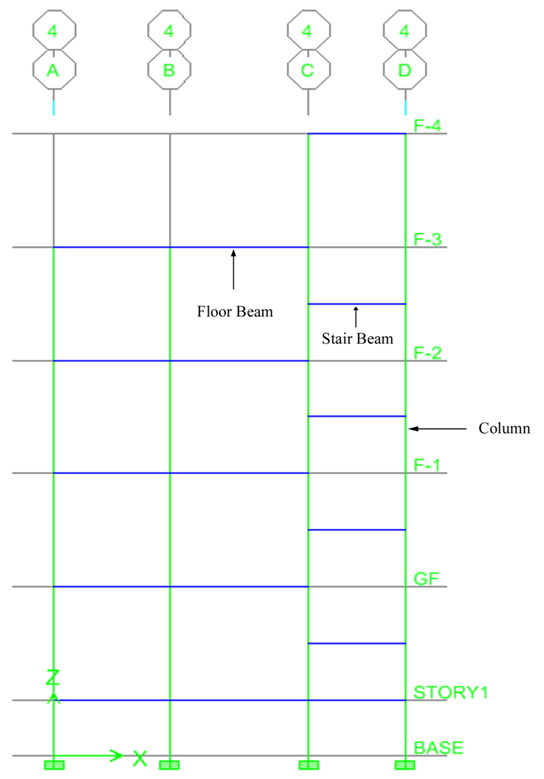
Figure : Typical Short Section of Option I Building
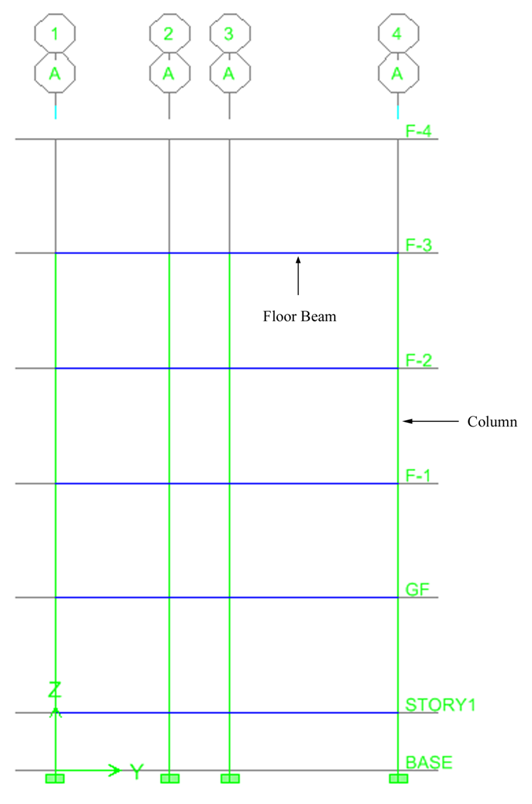
Figure : Typical Long Section of Option I Building
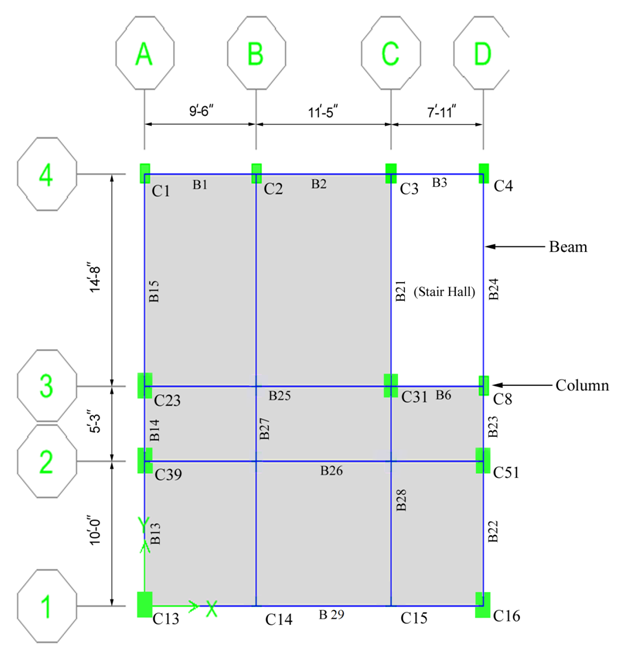
Figure : Option II Building ( Ground Floor )
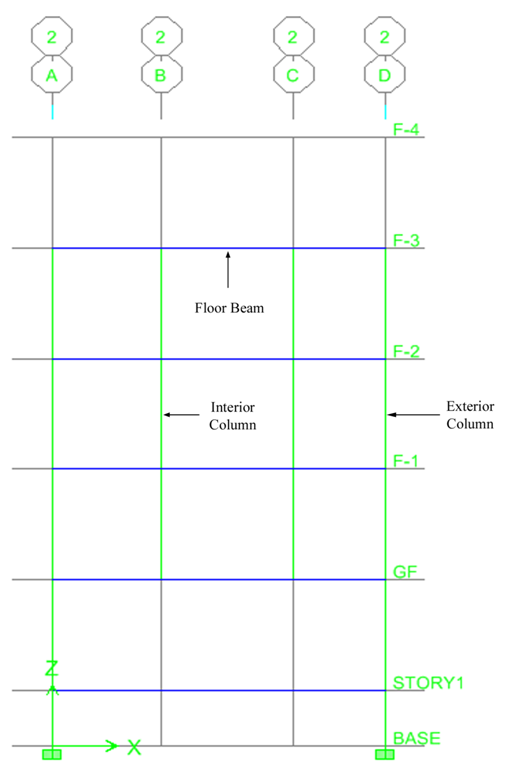
Figure : Typical Short Section of Option II Building
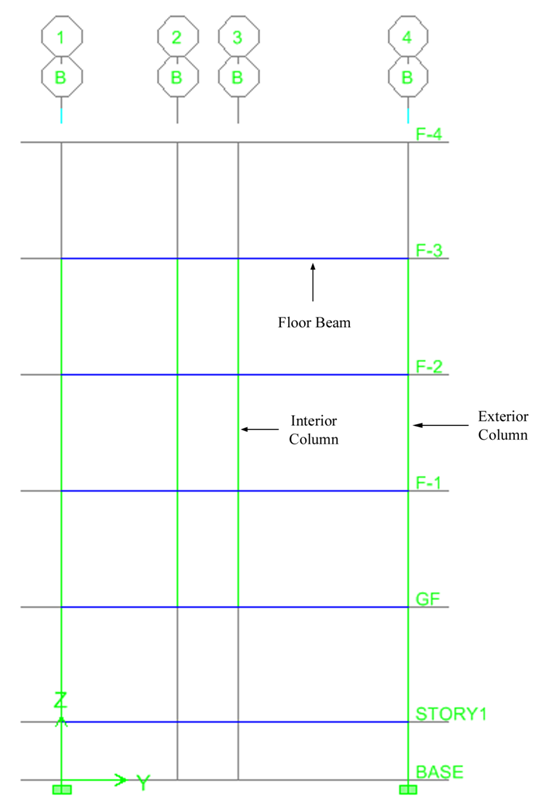
Figure : Typical Long Section of Option II Building

Figure : Option I Building (3D View)
Table 4.2 : Analysis result of beams for option I building
Beam | +M (k-ft) | -M (k-ft) | Vu (kip) |
B1 | 3.390 | 6.780 | 3.920 |
B2 | 6.007 | 12.014 | 4.710 |
B3 | 4.078 | 22.287 | 5.36 |
B4 | 5.174 | 10.348 | 5.386 |
B5 | 7.132 | 14.263 | 4.89 |
B6 | 5.254 | 22.646 | 3.76 |
B7 | 5.099 | 10.199 | 6.273 |
B8 | 6.377 | 12.754 | 4.825 |
B9 | 3.008 | 6.177 | 4.635 |
B10 | 3.295 | 6.590 | 3.938 |
B11 | 4.328 | 8.650 | 4.881 |
B12 | 1.752 | 3.503 | 2.669 |
B13 | 1.259 | 5.830 | 4.810 |
B14 | 1.591 | 3.183 | 1.445 |
B15 | 7.667 | 15.335 | 7.018 |
B16 | 2.281 | 11.249 | 1.976 |
B17 | 3.413 | 6.826 | 2.645 |
B18 | 7.331 | 29.574 | 1.835 |
B19 | 2.413 | 10693 | 1.835 |
B20 | 4.392 | 8.785 | 4.434 |
B21 | 9.223 | 18.447 | 7.795 |
B22 | 3.137 | 6.275 | 4.010 |
B23 | 3.050 | 6.099 | 3.701 |
B24 | 2.566 | 5.133 | 1.588 |
Analysis of building without interior columns
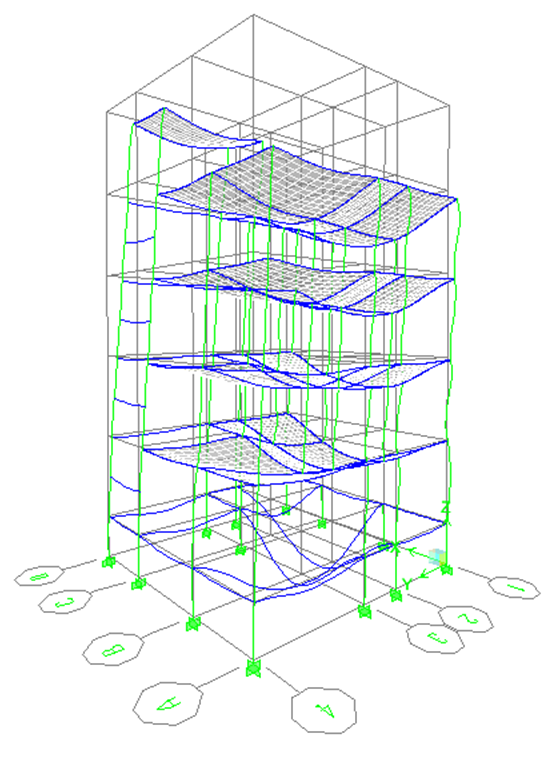 Figure : Building Without interior columns (3D View)
Figure : Building Without interior columns (3D View)
Table 4.3 : Analysis result of building columns for without interior columns
Column | Axial Force, P (kip) | M2 (k-ft) | M3 (k-ft) |
C1 | 45.255 | −5.893 | −9.683 |
C2 | 120.570 | −9.593 | −37.848 |
C3 | 129.763 | −12.738 | −11.916 |
C4 | 93.549 | −7.899 | −2.490 |
C17 | 118.438 | −9.228 | 82.607 |
C18 | 325.291 | −24.397 | −71.141 |
C8 | 100.163 | 7.892 | −10.268 |
C19 | 124.287 | −9.057 | 86.289 |
C20 | 105.086 | 17.347 | −64.576 |
C21 | 116.463 | −8.745 | 85.907 |
C22 | 113.620 | 9.154 | 92.722 |
Table 4.4 : Analysis result of building beams for without interior columns
Beam | +M (k-ft) | -M (k-ft) |
B1 | 4.313 | 8.627 |
B2 | 7.403 | 14.806 |
B3 | 4.613 | 23.805 |
B25 | 166.747 | 29.298 |
B6 | 11.006 | 23.010 |
B26 | 135.938 | 28.783 |
B27 | 139.538 | 30.370 |
B13 | 7.020 | 14.041 |
B14 | 5.266 | 10.533 |
B15 | 9.302 | 18.635 |
B28 | 30.156 | 60.312 |
B29 | 23.380 | 46.761 |
B21 | 13.104 | 26.208 |
B22 | 7.260 | 14.521 |
B23 | 3.632 | 7.205 |
B24 | 4.211 | 8.422 |
By comparing the above tables it is found that the axial forces of the columns and bending moment of the beams significantly increase.
Analysis by introducing bracing system at 45° angle and 7 ft height from the ground level

Figure : Bracing at 45° angle
Table 4.5 : Analysis result for frame at ground floor between Columns C19 & C20 at 45° Bracing on 7 ft height from the ground level.
Columns | Axial force, P (kip) | M2 (kip-ft) | M3 (kip-ft) |
C19 | 140.344 | -112.559 | 13.897 |
C20 | 126.821 | 90.207 | -12.499 |
Beam | +M | -M | Vu |
B26 | 149.067 | 6.088 | 26.375 |
Bracing | +M | -M |
L | 131.082 | 262.164 |
R | 100.839 | 201.679 |
Analysis by introducing bracing system at the point of terminated column and 6ft height from the ground level
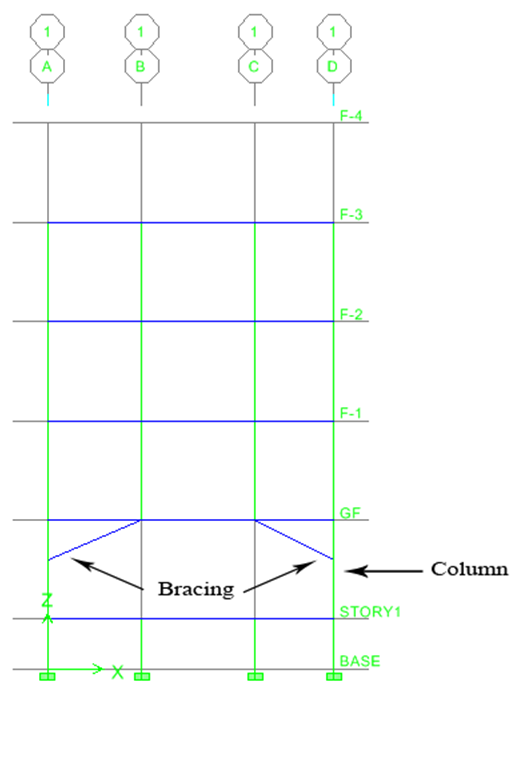 Figure : Bracing at point of termination of the columns
Figure : Bracing at point of termination of the columns
Table 4.6 : Analysis result for frame at ground floor between Columns C19 & C20 Bracing system at the point of terminated column on 6 ft height from the ground level.
Columns | Axial force, P (kip) | M2 (kip-ft) | M3 (kip-ft) |
C19 | 125.959 | 10.077 | 140.797 |
C20 | 123.383 | -10.717 | -127.62 |
Beam | +M | -M | Vu |
B26 | 73.197 | 8.855 | 5.639 |
Bracing | +M | -M |
L | 10.175 | 20.349 |
R | 7.607 | 15.214 |
Solution:
From investigation of the above result it can be said that the internal forces of the building without interior columns is significantly increase. After bracing a huge amount of negative moment is produced the contact point of the bracing and the beam. As the bracing angle ( with the vertical ) is increase the beam positive moment also increase, but the negative moment has an unchanged effected. But in this case there is an advantage of reduced internal force of the bracing. It advantageous for positive moment for introducing bracing as low bracing angle as possible but as this way the negative moment can not be reduced. But if the bracing is introduced at the point where the interior columns are terminated as in figure 4.10, the reduced negative moment and slightly increased positive moment compared to the reduced bracing angle. At that time the hugely increased internal forces of the option II building is reduced substantially. We used terminated column bracing.
Analysis of option II building (With providing bracing system):

Figure : Building Without interior columns, but provided bracing
Table 4.7 : Analysis result of columns after providing bracing at the point of termination of the column for option II building :
Column | Axial Force, P (kip) | M2 (k-ft) | M3 (k-ft) |
C1 | 42.629 | 3.197 | 6.511 |
C2 | 117.423 | −9.394 | −31.620 |
C3 | 131.221 | 9.886 | −6.678 |
C4 | 95.302 | −8.040 | −1.047 |
C17 | 126.557 | 10.125 | 129.821 |
C18 | 301.559 | −29.736 | 116.536 |
C8 | 103.107 | 7.733 | −15.041 |
C19 | 125.959 | 16.077 | 140.536 |
C20 | 123.383 | −10.717 | −127.620 |
C21 | 115.408 | 9.990 | 179.680 |
C22 | 118.007 | 10.234 | −189.597 |
Table 4.8 : Analysis result of beams after providing bracing at the point of termination of the column for option II building :
Beam | +M (k-ft) | -M (k-ft) | Vu (kip) |
B1 | 3.642 | 7.284 | 3.675 |
B2 | 4.785 | 9.570 | 4.835 |
B3 | 22.454 | 4.749 | 1.342 |
B25 | 97.467 | 14.803 | 5.804 |
B6 | 14.447 | 28.894 | 19.808 |
B26 | 75.896 | 9.106 | 5.790 |
B27 | 72.632 | 8.439 | 7.509 |
B13 | 5.358 | 10.716 | 4.904 |
B14 | 4.257 | 8.513 | 3.839 |
B15 | 8.042 | 16.084 | 9.870 |
B28 | 26.048 | 52.096 | 19.870 |
B29 | 17.468 | 34.936 | 14.007 |
B21 | 11.402 | 22.804 | 4.886 |
B22 | 5.359 | 10.718 | 4.947 |
B23 | 9.622 | 19.244 | 2.967 |
B24 | 3.048 | 6.096 | 1.769 |
Table 4.9 : Analysis of bracings:
Bracing | +M (k-ft) | −M (k-ft) |
BR1 | 10.249 | 20.498 |
BR2 | 9.433 | 18.866 |
BR3 | 10.175 | 20.349 |
BR4 | 7.815 | 15.630 |
BR5 | 10.304 | 20.608 |
BR6 | 8.102 | 16.204 |
Design Work:
For option I building:
Table 4.10 : Ground floor columns reinforcement–
Column | Size ( in x in ) | Reinforcement |
C1 | 10 x 15 | Use 6 #5 with #3 Tie bar @ 10″ c/c |
C2 | 10 x 15 | Use 6 #5 with #3 Tie bar @ 10″ c/c |
C3 | 10 x 15 | Use 6 #5 with #3 Tie bar @ 10″ c/c |
C4 | 10 x 15 | Use 6 #5 with #3 Tie bar @ 10″ c/c |
C5 | 10 x 15 | Use 6 #5 with #3 Tie bar @ 10″ c/c |
C6 | 10 x 15 | Use 6 #5 with #3 Tie bar @ 10″ c/c |
C7 | 10 x 15 | Use 6 #5 with #3 Tie bar @ 10″ c/c |
C8 | 10 x 15 | Use 6 #5 with #3 Tie bar @ 10″ c/c |
C9 | 10 x 15 | Use 6 #5 with #3 Tie bar @ 10″ c/c |
C10 | 10 x 15 | Use 6 #5 with #3 Tie bar @ 10″ c/c |
C11 | 10 x 15 | Use 6 #5 with #3 Tie bar @ 10″ c/c |
C12 | 10 x 15 | Use 6 #5 with #3 Tie bar @ 10″ c/c |
C13 | 10 x 15 | Use 6 #5 with #3 Tie bar @ 10″ c/c |
C14 | 10 x 15 | Use 6 #5 with #3 Tie bar @ 10″ c/c |
C15 | 10 x 15 | Use 6 #5 with #3 Tie bar @ 10″ c/c |
C16 | 10 x 15 | Use 6 #5 with #3 Tie bar @ 10″ c/c |
Typical column size should be remain same.
Table 4.11 : Ground floor beam reinforcement
Beams | Size ( in x in ) | Main Reinforcement | Shear Reinforcement | ||
Main bar | Extra bar | ||||
B1 | 10 x 12 | For Support | For Middle | ― | #3 @ 4.5″c/c |
4 #5 St. | 4 #5 St. | ||||
B2 | 10 x 12 | For Support | For Middle | ― | #3 @ 4.5″c/c |
4 #5 St. | 4 #5 St. | ||||
B3 | 10 x 12 | For Support | For Middle | ― | #3 @ 4.5″c/c |
4 #5 St. | 4 #5 St. | ||||
B4 | 10 x 12 | For Support | For Middle | ― | #3 @ 4.5″c/c |
4 #5 St. | 4 #5 St. | ||||
B5 | 10 x 12 | For Support | For Middle | ― | #3 @ 4.5″c/c |
4 #5 St. | 4 #5 St. | ||||
B6 | 10 x 12 | For Support | For Middle | ― | #3 @ 4.5″c/c |
4 #5 St. | 4 #5 St. | ||||
B7 | 10 x 12 | For Support | For Middle | ― | #3 @ 4.5″c/c |
4 #5 St. | 4 #5 St. | ||||
B8 | 10 x 12 | For Support | For Middle | ― | #3 @ 4.5″c/c |
4 #5 St. | 4 #5 St. | ||||
B9 | 10 x 12 | For Support | For Middle | ― | #3 @ 4.5″c/c |
4 #5 St. | 4 #5 St. | ||||
B10 | 10 x 12 | For Support | For Middle | ― | #3 @ 4.5″c/c |
4 #5 St. | 4 #5 St. | ||||
B11 | 10 x 12 | For Support | For Middle | ― | #3 @ 4.5″c/c |
4 #5 St. | 4 #5 St. | ||||
B12 | 10 x 12 | For Support | For Middle | ― | #3 @ 4.5″c/c |
4 #5 St. | 4 #5 St. | ||||
For option II building:
Table 4.12 : Ground floor columns reinforcement–
Column | Size ( in x in ) | Reinforcement |
C1 | 10 x 15 | Use 6 #5 with #3 Tie bar @ 10″ c/c |
C2 | 10 x 15 | Use 6 #5 with #3 Tie bar @ 10″ c/c |
C3 | 10 x 15 | Use 6 #5 with #3 Tie bar @ 10″ c/c |
C4 | 10 x 15 | Use 6 #5 with #3 Tie bar @ 10″ c/c |
C17 | 10 x 18 | Use 6 #5 with #3 Tie bar @ 10″ c/c |
C18 | 10 x 18 | Use 8 #6 with #3 Tie bar @ 10″ c/c |
C8 | 10 x 15 | Use 6 #5 with #3 Tie bar @ 10″ c/c |
C19 | 10 x 18 | Use 6 #5 with #3 Tie bar @ 10″ c/c |
C20 | 10 x 18 | Use 6 #5 with #3 Tie bar @ 10″ c/c |
C21 | 10 x 18 | Use 6 #5 with #3 Tie bar @ 10″ c/c |
C22 | 10 x 18 | Use 6 #5 with #3 Tie bar @ 10″ c/c |
Table 4.13 : Ground floor beam reinforcement
Beams | Size ( in x in ) | Main Reinforcement | Shear Reinforcement | ||
Main bar | Extra bar | ||||
B1 | 10 x 12 | For Support | For Middle | ― | #3 @ 4.5″c/c |
4 #5 St. | 4 #5 St. | ||||
B2 | 10 x 12 | For Support | For Middle | ― | #3 @ 4.5″c/c |
4 #5 St. | 4 #5 St. | ||||
B3 | 10 x 12 | For Support | For Middle | ― | #3 @ 4.5″c/c |
4 #5 St. | 4 #5 St. | ||||
B25 | 10 x 20 | For Support | For Middle | 2#5 Ext. bottom | #3 @ 8.5″c/c |
4 #5 St. | 4 #5 St. | ||||
B6 | 10 x 12 | For Support | For Middle | ― | #3 @ 4.5″c/c |
4 #5 St. | 4 #5 St. | ||||
B26 | 10 x 20 | For Support | For Middle | 1#6 Ext. bottom | #3 @ 8.5″c/c |
4 #5 St. | 4 #5 St. | ||||
B27 | 10 x 20 | For Support | For Middle | 1#6 Ext. bottom | #3 @ 8.5″c/c |
4 #5 St. | 4 #5 St. | ||||
B13 | 10 x 12 | For Support | For Middle | ― | #3 @ 4.5″c/c |
4 #5 St. | 4 #5 St. | ||||
B14 | 10 x 12 | For Support | For Middle | ― | #3 @ 4.5″c/c |
4 #5 St. | 4 #5 St. | ||||
B15 | 10 x 12 | For Support | For Middle | ― | #3 @ 4.5″c/c |
4 #5 St. | 4 #5 St. | ||||
B28 | 10 x 20 | For Support | For Middle | 1#5 Ext. top | #3 @ 8.5″c/c |
4 #5 St. | 4 #5 St. | ||||
B29 | 10 x 20 | For Support | For Middle | ― | #3 @ 8.5″c/c |
4 #5 St. | |||||
Table 4.14 : Bracing steel
Bracing | Steel Section (Use A36 Steel) |
BR1 | W8 x 15 |
BR2 | W8 x 15 |
BR3 | W8 x 15 |
BR4 | W8 x 15 |
BR5 | W8 x 15 |
BR6 | W8 x 15 |
Detailing of the elements of the building:
Option I Building:
Columns section for Option I building:
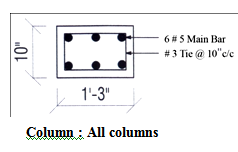
Figure : Ground floor and typical floor all column details
Beams section for Option I building:
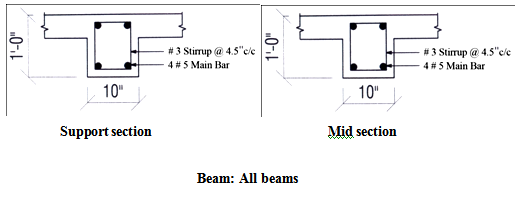
Figure : Ground floor and typical floor all beam details
Option II Building:
Columns section for Option II building:
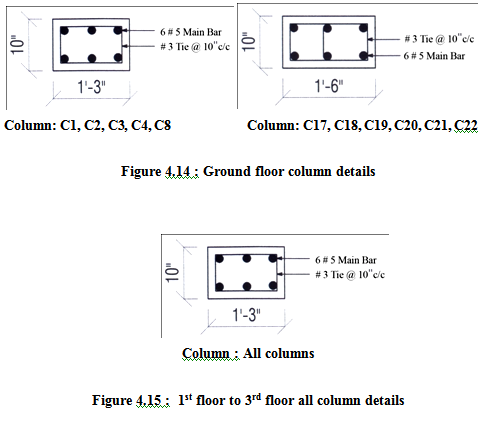
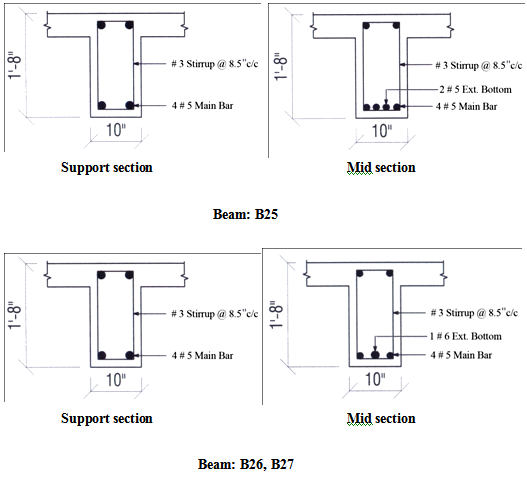
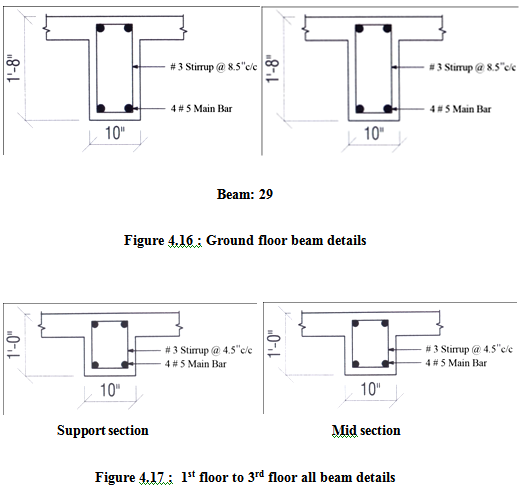
Bracing steel section:
Here,
A= 4.44 sq. in tf = 0.315 in
d = 8.11 in tw = 0.245 in
bf = 4.015 in
Figure 4.18 : Details of bracing steel
COMPARATIVE STUDY
General:
The buildings are analyzed for determine the best condition which can be constructed
economically. The behavior of each condition is observed carefully. Then suitable condition is selected and suitable dimensions as well as steel area are also determined. The chapter gives a comparative amount of the materials, dimensions etc required for both the option I and option II building. It is obvious that the amount of material required for option II building will be higher than the option I building. But the option II building got column free parking space. Though the saving of space due to reduction of columns in the ground floor is not large, even this columns free space would be able to provide smooth and efficient parking, easy access and exit as well better maneuverability.
Comparison between the buildings:
The comparison is made in terms of element dimensions, volume of concrete and steel requirement, their cost and economic view.
Table 5.1: Dimensions of the different elements of the building
Element | Option I building | Option II buildig |
| Column no. | There are 16 columns at each floor. So the total no of columns of four storied building is 16 x 4 = 64 | There are 11 columns at the ground floor and others floor have 16 columns. So the total no of columns of the building is 11 + 16 x 3 = 59 |
| Column size | All columns are 10″ x 15″ | Ground floor 6 column size are 10″ x 18″ and ground floor others 5 column and typical floor columns size 10″ x 15″ |
| Column height | All column height 10′-0″ | All column height 10′-0″ |
| Beams | All beams size is considered as 10″ x 12″ | Ground floor 5 beams size are 10″ x 20″ and others beam size are 10″ x 12″ |
| Bracing | No bracing required | 6 Nos. of W 8 x 15 steel section bracing provided. |
Table 5.2: Comparative concrete volume of both the buildings
Elements | Option I building | Option II building |
| Column: |
(10 x 15 x 10 x 16)/144 = 166.67 cft
Beam:
Ground floor total beam lenth = 235′
(10 x 12 x 235)/144 = 195.83 cft
Total ground floor beam & column concrete volume = 362.5 cftColumn:
C1,C2,C3,C4,C8 = (10 x 15 x 10 x 5)
/144 = 52.08 cft
C17,C18,C19,C20,C21,C22 =
(10 x 18 x 10 x 6) = 75 cft
Total column volume = 127.08 cft
Beam:
B25,B26,B27,B28,B29 =
(10 x 20 x 78.58)/144 = 109.14 cft
Oters beam lenth = (235-78.58)=156.42′
( 10 x 12 x 156.42)/144 = 130.35 cft
Total volume of beam = 239.49 cft Total GF beam & column concrete volume = 366.57 cftTypical floorTotal column volume = 166.67 cft
Total beam volume = 195.83 cft
Total typical floor beam & column concrete volume = 362.5 cftTotal column volume = 166.67 cft
Total beam volume = 195.83 cft
Total typical floor beam & column concrete volume = 362.5 cftFull buildingTotal beam & column concrete volume of the building = 1450 cftTotal beam & column concrete volume of the building = 1454.07 cft
Table 5.3: Comparative steel quantity
| Elements | Option I building | Option II building |
| Ground floor | Column: |
All column= 6#5 bars per column
Total reinforcement = ( 10 x 6 x 16)
= 960′-0″ x 0.481 = 461.75 kg
Shear reinforcement = (3.5 x 13 x 16)
= 728-0″ x 0.188 = 136.86 kg
Total column reinforcement =598.61 kg
Beam:
Total beam lenth = 235′
All beam have 4#5 main bars and no ext. bar use
Beam reinforcement= (235 x 4)
= 940 x 0.481 = 452.14 kg
Shear reinforcement = ( 601 x 3.00)
= 1803’−0″ x 0.188 = 338.96 kg
Total Beam reinforcement = 751.1 kg
Total ground floor beam & column reinforcement = 1389.71 kgColumn:
C1,C2,C3,C4,C8 = 6#5 bars per column
Reinforcement = (10 x 6 x 5) = 300′-0″
= 300 x 0.481 = 144.3 kg
C17,C19,C20,C21,C22 = 6#5 bars per column, reinforcement = (10 x 6 x 5)
= 300′-” x 0.481 = 144.3 kg
C18 = 8#6 bars, reinforcement= (10×8)
= 80’−0″ x 0.752 = 60.16 kg
Shear reinforcement = (3.5 x 13 x 5) + (4.00 x 13 x 6) = 539.5′ x 0.188 = 101.43 kg
Total column reinforcement = 450.19 kg
Beam:
B1,B2,B3 = (29.67 x 4 x 0.481)
= 57.1 kg
B6 = (8.33 x 4 x 0.481) = 16 kg
| Elements | Option I building | Option II building |
| Ground floor | B13,B14,B15 = (30.58 x 4 x 0.481) |
= 58.83 kg
B21= (15.08 x 4 x 0.481) = 29 kg
B22,B23,B24 = (30.58 x 4 x 0.481)
= 58.83 kg
B25 = (21.33 x 4 x 0.481) + (16 x 2 x 0.481) = 56.43 kg
B26 = (29.67 x 4 x 0.481) + (22.5 x 1 x 0.752) = 74 kg
B27 = (30.58 x 4 x 0.481) + (23 x 1 x 0.752) = 76.13 kg
B28 = (15.67 x 4 x 0.481) + (4.5 x 2 x 0.481) = 34.48 kg
B29 = (30.58 x 4 x 0.481) = 58.84 kg
Shear reinforcement = (204 x 3.00 x 0.188) + (221 x 4.33 x 0.188) = 294.96 kg
Total steel for beam = 785.6 kg
Total GF beam & column reinforcement = 1235.79 kgBracing steelNo bracing useUse W 8 x 15 section
Total Bracing length= (10.31 x 3) + (8.873 x 2) + 12.10 = 60.78′
Weight = 60.78 x 6.8 = 413.30 kgTypical floorTotal column reinforcement =598.61 kg
Total Beam reinforcement = 751.1 kg
Total beam & column reinforcement = 1389.71 kgTotal column reinforcement =598.61 kg
Total Beam reinforcement = 751.1 kg
Total r beam & column reinforcement = 1389.71 kgTotal buildingTotal building beam & column reinforcement quantity = 5558.84 kgTotal building beam & column reinforcement quantity = 5404.92 kg
Total bracing steel = 413.30 kg
Costing of the both types of building:
The cost analysis is completed according to “ Schedule of rate for civil works”, 2008 12th edition, PWD and as per considerations.
Cost of option I building (For beam & column)
Total volume of concrete = 1450 cft
Total cost for concrete = ( 1450 x 267 ) = 3,87,150 Tk.
Total quantity of steel = 5558.84 kg
Total cost for steel = ( 5558.84 x 63 ) = 3,50,207 Tk.
Total cost for option I building = 387150 + 350207 = 7,37,357 Tk.
Cost of option II building (For beam & column):
Total volume of concrete =1454.07 cft
Total cost for concrete =( 1454.07 x 267 ) = 3,88,237 Tk.
Total quantity of steel = 5404.92 kg
Total cost for steel = ( 5404.92 x 63 ) = 3,40,510 Tk.
Total bracing quantity of steel = 413.30 kg
Total bracing cost for steel = ( 413.30 x 110 ) = 45,463 Tk.
Total cost for option I building = 388237 + 340510 + 45463 = 7,74,210 Tk.
It is found that the building with 11 columns at ground floor provide more column free space but require additional material and construction cost. From our investigation it is found that option II building requires 0.3% more concrete and 4.66% more steel. The total cost increased by an amount of Tk. 36,853.
CONCLUTION AND RECOMMENDATION
General:
In this study four storied building with varying number of columns at ground floor were analyzed using ETABS finite element package. The study has been made primarily with view to explore or to investigate the possibility of obtaining an uninterrupted column free space so as to make the efficient use of land demarcated for parking. From the analysis the following conclusion can be drawn.
Conclusion:
From the analysis result it can be said that the internal forces of the building without interior column is significantly increase . After introducing bracing a huge amount of negative moment is produced the contact point of the bracing and the beam. As the bracing angle ( with the vertical ) is increase the beam positive moment also increase, but the negative moment has an unchanged effected. But in this case there is an advantage of reduced internal force of the bracing. It advantageous for positive moment for introducing bracing as low bracing angle as possible but as this way the negative moment can not be reduced. But if the bracing is introduced at the point where the interior columns are terminated as in figure 4.10, the reduced negative moment and slightly increased positive moment compared to the reduced bracing angle. At that time the hugely increased internal forces of the option II building is reduced substantially.
On the other investigation it is found that the building with 11 columns at ground floor provide more column free space but require additional material and construction cost. From our investigation it is found that option II building requires 0.3% more concrete and 4.66% more steel. The total cost increased by an amount of Tk. 36,853.
Recommendation:
For further study in this field, the following recommendations are put forward:
- Instead of steel section as bracing, the R.C section can be used.
- Steel truss or concrete truss can be used to transfer the load above ground floor to the foundations.
REFERENCES:
- ACI Code, 2005, USA.
- BNBC, (1993) : Bangladesh National Building Code, 1st Edition, City Art Press, Dhaka, Bangladesh.
- ETABS V 8.2.7
- PWD, (2008) : Schedule of Rate for Civil Works, 12th Edition, Public Works Department, Govt. of People Republic of Bangladesh.
- Winter and Nilson, (2003) : “Design of Concrete Structure”, 13th Edition, McGraw-Hill International editions, New Delhi, India.
